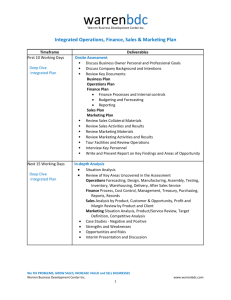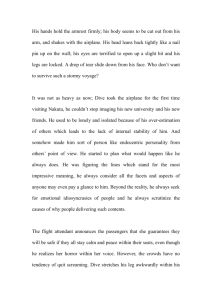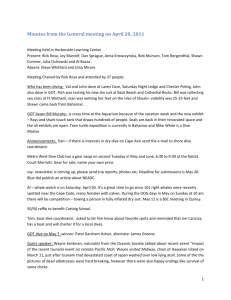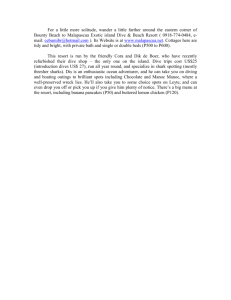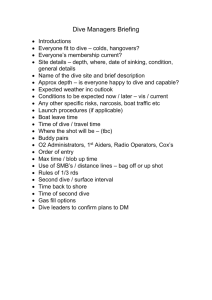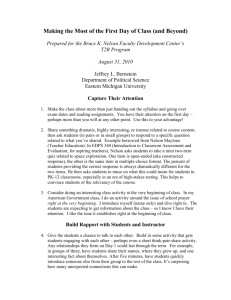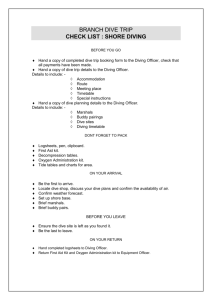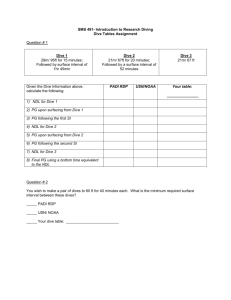Unit 5 Dive Tables and Dive Computers
advertisement
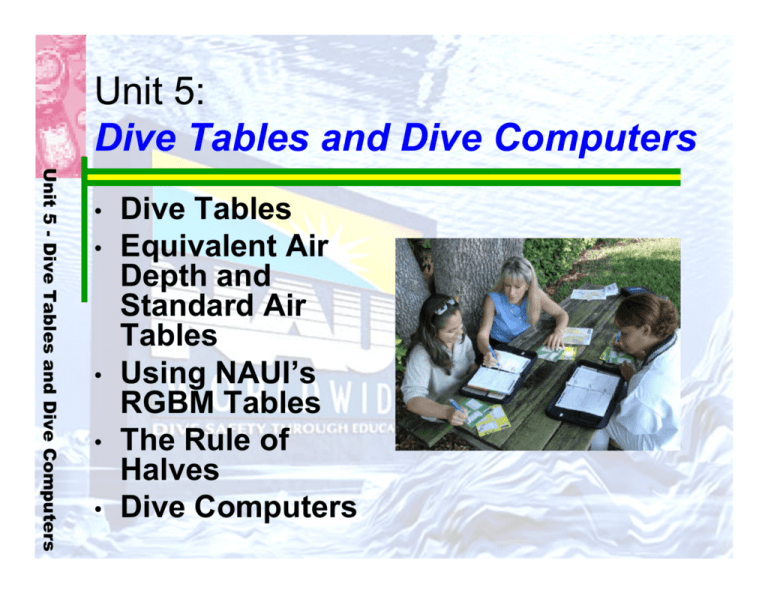
Unit 5: Dive Tables and Dive Computers Unit 5 - Dive Tables and Dive Computers • • • • • Dive Tables Equivalent Air Depth and Standard Air Tables Using NAUI’s RGBM Tables The Rule of Halves Dive Computers Student Performance: By the end of the lesson you will be able to: Unit 5 - Dive Tables and Dive Computers • Demonstrate the use of NAUI EANX Dive Tables. • Define Equivalent Air Depth and how it is used with Air Dive Tables. • Demonstrate how to determine and calculate Equivalent Air Depth. • Demonstrate the use of the NAUI RGBM Nitrox Dive Tables. • State the “Rule of Halves” and how to use it in all of your diving. • Describe the procedures for using dive computers for EANX diving. Dive Tables Unit 5 - Dive Tables and Dive Computers • There are many different dive tables in use today – NAUI Dive Tables – NAUI RGBM Tables – U.S. Navy Tables – DCIEM Tables – Buhlmann based tables – Other Tables Air Dive Tables Unit 5 - Dive Tables and Dive Computers • So-called “standard dive tables” are designed for diving while breathing air. No-required Stop Times Unit 5 - Dive Tables and Dive Computers • EANx Dive Tables give increased maximum dive times for standard mixes. Unit 5 - Dive Tables and Dive Computers Enriched Air Nitrox Dive Tables • Enriched Air Nitrox Tables Unit 5 - Dive Tables and Dive Computers Enriched Air Nitrox Dive Tables continued • NAUI EAN Dive Table Rules – Treat each dive as a square profile dive, with the deepest point reached on the dive being used as the depth for the whole dive. – If the exact depth or time does not appear on the table, round up to the next greater number. – The tables assume an ascent rate of 30 feet/9 meters per minute. – Planning repetitive dives progressively shallower will yield shorter required surface interval times. – The required surface interval between two separate dives is 10 minutes; the minimum recommended surface interval is one hour. – The tables are designed to be used at sea-level atmospheric pressure, and adjustments must be made for altitudes above about 1000 feet/300 meters. – If flying or ascending to altitude after diving, wait 12 hours after a single dive and 18 hours after a repetitive dive series. Equivalent Air Depth and Standard Air Tables Unit 5 - Dive Tables and Dive Computers • Equivalent Air Depth is determined by the partial pressure of nitrogen that the diver is actually breathing – Because nitrox has a lower fraction of nitrogen than air, the nitrogen partial pressure will also be less than with air for any given depth, and the diver’s equivalent depth for nitrogen absorption will also be less than with air. – It is not the actual depth, but the partial pressure of nitrogen in the breathing gas that matters. Equivalent Air Depth and Standard Air Tables continued Unit 5 - Dive Tables and Dive Computers • EAD Example: – If you were breathing a mixture that is 36% oxygen, then the nitrogen percentage would be 64%, and the nitrogen fraction would be 0.64. – When you dive with this mixture, you expose yourself to 64/79ths the nitrogen partial pressure that you would encounter if breathing air. – Therefore, you can consider your depth to be 64/79ths (roughly 80%) of the absolute pressure that you would encounter at your actual depth if you were breathing air. Equivalent Air Depth and Standard Air Tables continued Unit 5 - Dive Tables and Dive Computers • Equivalent Air Depth by Table (imperial) Unit 5 - Dive Tables and Dive Computers Equivalent Air Depth and Standard Air Tables continued • Equivalent Air Depth by Table (metric) Equivalent Air Depth and Standard Air Tables continued Unit 5 - Dive Tables and Dive Computers • Calculating Equivalent Air Depth • Equivalent air depth can be calculated in discrete steps, or the procedure can be combined into a single formula. • Step 1: Determine the absolute pressure at the depth to which you will be diving. • Step 2: Apply the nitrogen “credit” that your nitrox blend gives you. • Step 3: Convert this air-equivalent absolute pressure to an equivalent air depth Equivalent Air Depth and Standard Air Tables continued Unit 5 - Dive Tables and Dive Computers • • • • • • Step 1: P ata = (D fsw / 33 fsw/atm) + 1 atm Step 2: P ataEAD = (Fin mix / Fin air) x P ata Step 3: EAD fsw = (P ataEAD – 1 atm) x 33 fsw/atm Equivalent Air Depth and Standard Air Tables continued Unit 5 - Dive Tables and Dive Computers • Calculating EAD – Example: What is the equivalent air depth for a diver diving with EAN32 to a depth of 80 feet/24 meters? Step 1: Find the absolute pressure at 80 fsw using the formula from Chapter 2: or = 3.42 ata Equivalent Air Depth and Standard Air Tables continued Unit 5 - Dive Tables and Dive Computers • Calculating EAD – Step 2: Apply your nitrogen “credit.” Since you are diving with EAN32, the nitrogen fraction of your mix is 0.68 (= 1.0 - 0.32). Your air-equivalent absolute pressure is set by the ratio between the fraction of nitrogen in your mix and the fraction of nitrogen in air, or: P ata (air equiv) = (0.68/0.79) x 3.42 ata = 2.94 ata Equivalent Air Depth and Standard Air Tables continued Unit 5 - Dive Tables and Dive Computers • Calculating EAD – Step 3: Convert 2.94 ata to an equivalent air depth: – D fsw = (P ata – 1 atm) x 33 fsw / atm – D fsw = (2.94 ata – 1 atm) x 33 fsw / atm = 64 fsw – You would use for 70 feet / 21 meters on your dive tables. Equivalent Air Depth and Standard Air Tables continued Unit 5 - Dive Tables and Dive Computers • Calculating EAD using a single formula ( D fsw + 33 fsw ) x FN2 EAD fsw = - 33 fsw 0.79 ( D fsw + 33 fsw ) + (1 - FO2 ) EAD fsw = - 33 fsw 0.79 Equivalent Air Depth and Standard Air Tables continued Unit 5 - Dive Tables and Dive Computers • Calculating EAD with the OCEANx – To find equivalent air depth with the OCEANx calculator, dial-in the oxygen percentage into the upper window. The long window immediately below shows the maximum actual depth to be used with each equivalent air depth, which is printed immediately to the right. Using NAUI’s RGBM Tables Unit 5 - Dive Tables and Dive Computers • • • NAUI RGBM Dive Tables are “NoCalculation” tables and do not require use of letter groups, a surface interval credit table, or residual nitrogen times, thus making repetitive dive planning extremely easy and straightforward. NAUI RGBM Dive Tables have been prepared for EAN32 and EAN36 as well as for air diving. The sea-level tables provide dive-planning information for altitudes up to 2000 feet/610 meters. Additional sets of tables are available for diving at altitudes between 2000 and 6000 feet/610 to 1829 meters and for 6000 and 10,000 feet/1829 to 3048 meters. Using NAUI’s RGBM Tables continued Unit 5 - Dive Tables and Dive Computers • The important RGBM table rules are: – A minimum surface interval of one hour is required between each dive. – If the actual dive depth is not listed, round up to the next greater depth. – The depth of each repetitive dive must be no greater than the depth shown on the row immediately to the right of the previous dive’s depth; of course, it may be shallower than this maximum repetitive-dive depth. Using NAUI’s RGBM Tables continued Unit 5 - Dive Tables and Dive Computers • The important RGBM table rules are: – As the tables are designed, there can be no shallow dive followed by a deeper dive. – The maximum ascent rate is 30 feet/9 meters per minute. – All dives require a 3-minute safety stop at 15 feet (± 3 feet)/5 meters (± 1 meter) Using NAUI’s RGBM Tables continued Unit 5 - Dive Tables and Dive Computers • The important RGBM table rules are: – On the sea level to 2,000 feet tables, no more than three repetitive dives within a 12-hour period. In actual practice, the “third dive” may be a series of repetitive dives not exceeding the total maximum dive time of 150 minutes. – The flying after diving rule is to wait at least 12 hours after a single dive within the prior 18hour period, 15 hours after two dives, and 18 hours after three dives. Using NAUI’s RGBM Tables continued Unit 5 - Dive Tables and Dive Computers • Dive example (using EAN32) – Dive 1: 24 m/80 feet for 47 minutes – 1hour Surface Interval – Dive 2: 18 m/60 feet for 85 minutes – 1 hr Surface Interval – Dive 3: 12 m/40 feet for up 150 minutes Using NAUI’s RGBM Tables continued Unit 5 - Dive Tables and Dive Computers • When using the NAUI RGBM Tables, you may also switch tables from leaner to richer oxygen fractions from dive one to dive two (or dive two to dive three) by simply following the maximum depth constraints as you move between the appropriate dive tables. • For example, it is possible to use air and the NAUI RGBM Air Table on Dive One, then switch to EAN36 and use the RGBM EAN36 Table on Dive Two. Rule of Halves Unit 5 - Dive Tables and Dive Computers • When ending any no-decompression dive in excess of 12 meters / 40 feet, halve the distance from the dive’s deepest depth to the surface. Ascend to that depth and make a one-minute safety stop. Then continue your ascent to the 5 meter/15 foot safety stop and complete the last two minutes of your three-minute safety stop at 5 meters/15 feet. Dive Computers and Nitrox Unit 5 - Dive Tables and Dive Computers • Dive computers perform real time dive calculations. • Generally, their algorithms are quite conservative. • Because they sample the diver’s depth and dive time every few seconds and recalculate nitrogen absorption over a range of theoretical tissue compartments, divers enjoy extended dive times when using a dive computer. • In effect, the diver receives “credit” for the shallow portions of the dive, which is not possible with the “square-profile” assumptions of dive tables. Dive Computers and Nitrox Unit 5 - Dive Tables and Dive Computers continued • Two basic options – Use a Nitrox capable computer – Use an Air capable computer to increase your safety margins. Note: Currently, many manufacturers have incorporated the NAUI RGBM algorithms as well as the NAUI Rule of Halves into their dive computers. End of Unit 5 Unit 5 - Dive Tables and Dive Computers Dive Tables and Dive Computers • • • • • Dive Tables Equivalent Air Depth and Standard Air Tables Using NAUI’s RGBM Tables The Rule of Halves Dive Computers Student Performance: By the end of the lesson you will be able to: Unit 5 - Dive Tables and Dive Computers • Demonstrate the use of NAUI EANx Dive Tables. • Define Equivalent Air Depth and how it is used with Air Dive Tables. • Demonstrate how to determine and calculate Equivalent Air Depth. • Demonstrate the use of the NAUI RGBM Nitrox Dive Tables. • State the “Rule of Halves” and how to use it in all of your diving. • Describe the procedures for using dive computers for EANx diving.
